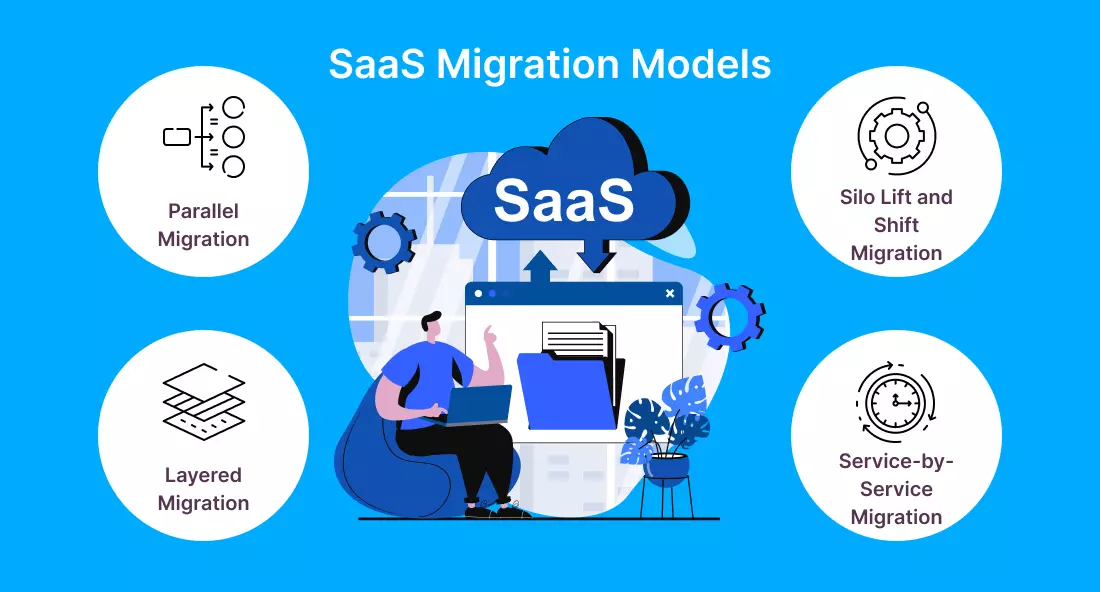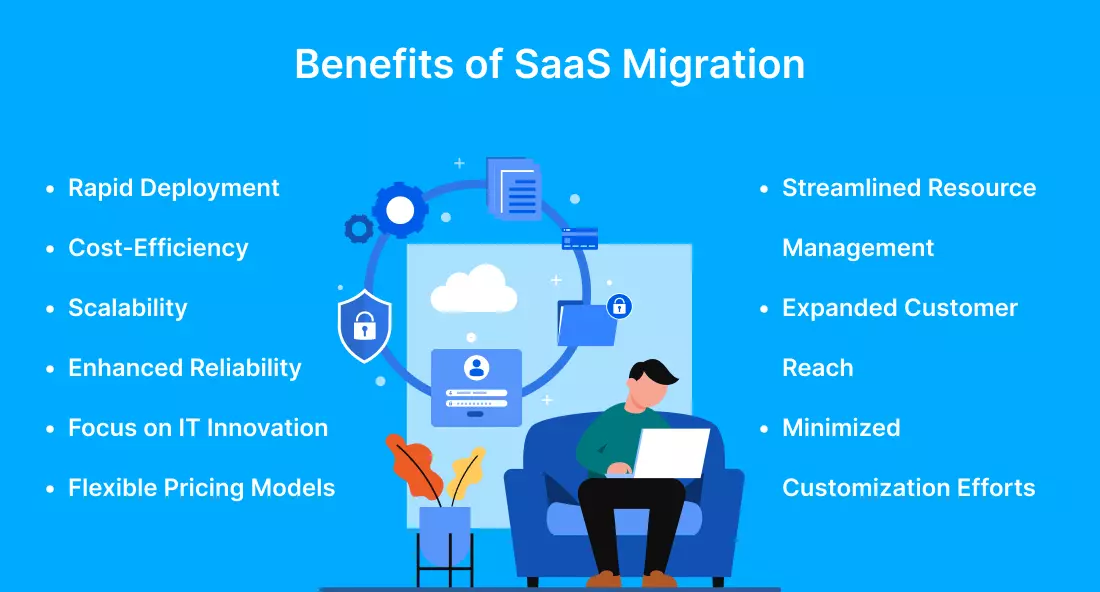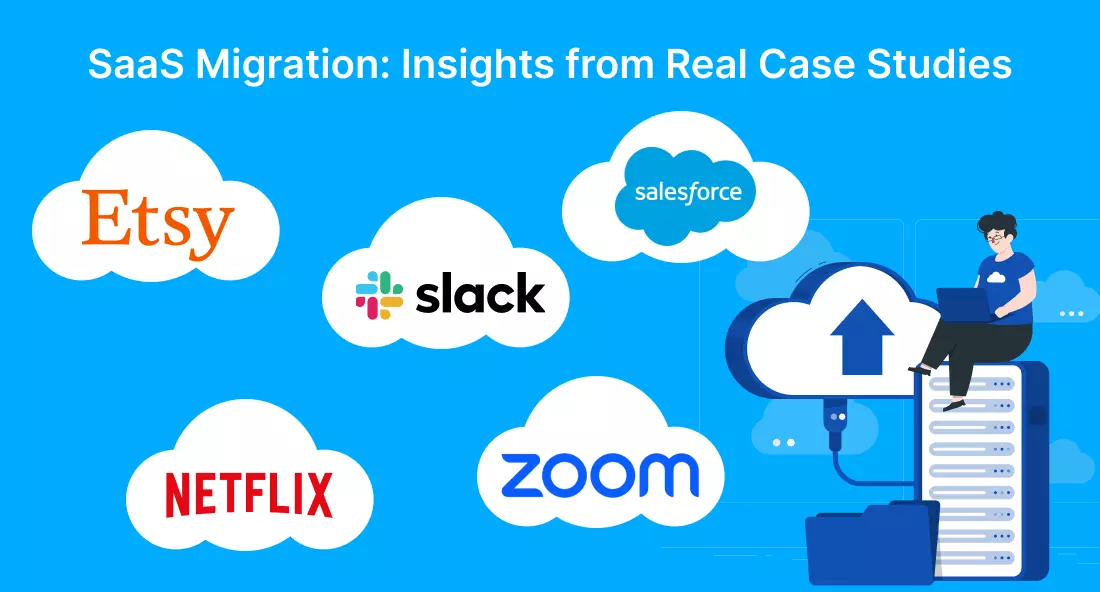Summary:
The blog provides a comprehensive SaaS migration guide for businesses aiming to transition their technology infrastructure to cloud-based solutions smoothly. We will go through different SaaS migration approaches, dive into the potential challenges to overcome, and further outline the advantages it brings to the table.
Table of Contents
Introduction
In this rapidly evolving business environment, staying at the front line requires organizations to embrace technological advancements. Among the most substantial transformations in recent years is the growing prominence of cloud-based solutions, with SaaS leading the charge. This shift offers numerous benefits, sparing organizations from the upfront costs and complexities of managing on-premises software while ensuring access to the latest software.
As a result, SaaS migration has emerged as a critical strategy for businesses aiming to stay ahead of the digital revolution and embrace the full potential of cloud-based innovations. However, to decide whether SaaS migration is the right move for your organization, it’s essential to understand what it encompasses and how it should be executed. So, let’s dive in!
SaaS Migration: Why Businesses Are Making the Shift?
Four significant market trends drive enterprises’ increasing adoption of SaaS cloud migration. These trends are shaped by changing economic conditions that emphasize core competencies, intense global competition, the need for mobility and information access in modern workplaces, and limitations posed by traditional infrastructure.
In addition to these factors, the following statistics can provide clear evidence for why SaaS is considered the future and why businesses are eager to embrace this shift:
✅ Projected Data Growth: By 2025, it is estimated that the cloud will store over 100 zettabytes of data, driving substantial growth in the SaaS cloud.
✅ Market Spending: According to Gartner’s 2021 data, spending on cloud application services surpassed Infrastructure as a Service (IaaS) and Platform as a Service (PaaS), with end-user spending exceeding $152 billion, highlighting the value of such investments for growth and competitiveness.
✅ Future Growth: Gartner’s predictions indicate that SaaS will continue to grow, with end-user spending expected to exceed $208 billion.
These factors represent the key drivers behind the shift to SaaS migration. The statistics reinforce its importance in the business landscape as to why it is an essential shift that businesses must undertake to prosper and maintain competitiveness.
SaaS Migration Models
The way you switch to SaaS can make a big difference in how well your business does. While some methods allow you to switch in one place directly, others will enable you to move alongside your existing setup. Below are a few of them:

Parallel Migration
Keeping old and new systems running together can be expensive and use up resources. The Parallel Migration model solves this issue; it creates entirely new software using a different setup, where the new software can be more flexible and adaptable to your needs. You can gradually move users to the new systems when ready and monitor how well they perform afterward. This approach is for businesses that cannot afford risks, even though it might take longer.
Layered Migration
The Layered Migration model allows you to move each layer of a single-tenant system. Unlike traditional data migrations, the layer migration approach moves individual layers or components one by one without disrupting the overall structure of the single-tenant system. This model relies on parallel migration and automated provisioning as its key components. While it is not a common technique, it’s effective for businesses transitioning from a single-tenant setup to a shared multi-tenant one.
Silo Lift and Shift Migration
The Silo Lift and Shift Migration model provides a simple method to transfer your entire system to the cloud. With the help of this approach, you can effortlessly move your complete technology setup from your on-premise infrastructure to the cloud-native environment without making significant changes. However, planning for tools, data storage, and other resources your application might need in the new environment is always essential. It is suitable for choice for organizations that can only rewrite their applications partially.
Service-by-Service Migration
In the Service-by-Service Migration model, your first task is to choose how to segment your single system into distinct services and subsequently automate each service independently. You can then gradually transform your system into SaaS using these autonomous services. Operating in a hybrid model that combines your existing setup, which keeps the application running, with the new microservices model is also essential. This model is ideal for businesses considering breaking down their system into microservices.
Are legacy systems holding you back?
Upgrade your SaaS game with hassle-free migration. Hire SaaS developers and transform your business to new heights of success!
Benefits Of SaaS Migration
Migrating to SaaS offers several advantages for businesses. Here are the key benefits:

🟠 Rapid Deployment
Utilizing traditional on-premise computer systems requires significant time to set up and customize the software to meet business ends, which can be tedious. But, with SaaS, the software is already designed, keeping the industry’s best practices in mind, enabling quick deployment. All you need is a web browser to access the application, which is easily accessible within a short period.
🟠 Cost-Efficiency
SaaS entails third-party providers handling software creation, management, hosting, and support, resulting in lower initial upfront costs. Here, you make regular payments similar to subscriptions, which makes it cost-efficient for businesses to shift from capital expenses on infrastructure to operating expenses.
🟠 Scalability
With SaaS cloud migration, you can easily adjust the usage of your software according to your needs, ensuring efficient operations in the long run. It assures efficient operations as your business grows or experiences any changes in demand.
🟠 Enhanced Reliability
When you migrate to a SaaS business model, the service provider manages everything, including operations, business continuity, and maintenance, ensuring the software remains reliable and operational. They also use service agreements to ensure you are on the same page and keep the operations running without interruptions.
🟠 Focus on IT Innovation
SaaS simplifies software usage by removing the need for installation and local server management. Instead, you can easily access these applications through web browsers or mobile apps, allowing your IT resources to focus on innovation and other important projects.
🟠 Flexible Pricing Models
Different models in SaaS migration offer flexible, usage-based pricing, ensuring cost efficiency and fairness. Businesses can pay for what they use and quickly adapt to the changing needs, maintaining the allocated budget with prediction.
🟠 Streamlined Resource Management
SaaS migration reduces the need for extensive in-house software maintenance, updates, and support resources. It streamlines resource management and leads to the more efficient allocation of personnel.
🟠 Expanded Customer Reach
SaaS business models help you offer your products and services in a way that attracts more customers and grows your customer base. Ditching the expensive traditional software development and moving your offering to the cloud, you can create more functional products that result in more self-enabling clients. A great sample of successful implementation of SaaS business models can be the case of customized printed on demand products on Shopify offered by the companies that learned to optimize their customer base that permits them to attract new clients and maintain long-term ones.
🟠 Minimized Customization Efforts
Creating custom software for individual clients can be substantially expensive and slow down the ability of your team to scale. With the help of SaaS, you can charge extra for customization, where you can satisfy your clients with standard solutions. Here, you can still offer custom options but at higher-priced plans. This factor reduces negotiation time and allows you to invest in customer service and add valuable features to your core services more effectively.
Additionally, as business owners recognize these benefits, integrating OpenAI for SaaS can help you with advanced AI capabilities that further enhance the efficiency of these SaaS solutions.
Mastering SaaS Migration: Overcoming Key Obstacles
Migrating to SaaS involves overcoming certain obstacles and being mindful of the potential challenges that might arise. Here are some key hurdles to be aware of and effective solutions to address them:
Migration Costs
While migrating to SaaS saves your money on infrastructure and maintenance expenses, additional expenses are allocated to migrating the data and processes to the new SaaS application. Also, your employees might require training to adapt to the new software. You can handle this issue by planning the budget for data transfer and employee training to manage the initial migration costs effectively.
Security Hurdles
Businesses must know the security hurdles when transitioning to the cloud, such as establishing strong data security policies and protecting sensitive information. Though the cloud provides specific measures, businesses are still responsible for defining their security policies, configurations, and assessments. There must always be clear communication between businesses and cloud providers to clarify roles and responsibilities in maintaining a secure environment and adhering to SaaS security best practices.
Interoperability Issues
Integrating SaaS applications with existing software is sometimes difficult if they do not work well together. It hampers the effective flow of data and operations within the company. To avoid this, conduct thorough compatibility tests and consider using middleware solutions to ensure seamless integration with the existing tools.
Dependable Connectivity
SaaS applications are accessed through web browsers or mobile apps, but always require a stable internet connection. SaaS becomes viable when you can access a dependable, high-speed internet connection. However, if your internet is unreliable, address this issue to ensure uninterrupted access to your cloud.
Vendor-Specific Integrations
Different SaaS vendors may have unique integration requirements, making it challenging to integrate various SaaS software solutions. To tackle this, assess the compatibility of your chosen SaaS applications with your existing technology stack. Look out for SaaS vendors that offer open APIs and support common integration standards.
Compatibility Obstacles
Efficient data exchange between SaaS applications and existing systems can be complex due to differences in the data format and structures. Investing in efficient data integration tools or platforms that enable smooth data transfer between different software solutions is always advisable. Also, ensure your data is well-structured and organized, simplifying the data exchange process.
Data-Exchange Difficulty
Optimizing data transfer between systems can be tricky. Your team must deeply understand your software, identify the issues, recognize which data needs to be moved, and create effective solutions. This process demands careful attention to the details. It is best to involve experts who can efficiently handle these data complexities. Professional analysis and a well-defined transition strategy help avoid budget overruns and underestimating the complexity of work involved in SaaS data migration.
Thus, when you explore how to migrate to SaaS, it is essential to assess your current infrastructure, choose the correct cloud provider, and develop a comprehensive SaaS migration strategy for a smooth transition.
Simplify your SaaS Migration Journey Today!
Partner with an experienced SaaS development company and make your move with confidence!
What Makes Bacancy Your Ultimate SaaS Migration Partner?
Bacancy emerges as the top-tier SaaS migration partner with expertise and proven track records of successful transitions. We don’t just follow the standard process; we craft a roadmap tailored to your specific business objectives. Our design prioritizes user experience, scalability, and security. We specialize in smooth transition management to keep your operations running smoothly. Additionally, with rigorous testing, we ensure a flawless SaaS application from day one. Bacancy is more than a partner; we are your trusted guide to a hassle-free transition to cloud-based solutions, setting your businesses on a growth path.
SaaS Migration: Insights from Real Case Studies
Here are a few top Fortune brands that have adopted SaaS cloud migration and paved their way to success:

🟠 Salesforce
Salesforce ranks among the top players in the SaaS industry. It started as a traditional software company and later transitioned to a cloud-based CRM platform offering various services, including SalesCloud, Service Cloud, and Marketing Cloud. With the SaaS transition, Salesforce provides its customers with scalable and flexible CRM solutions where the users can easily access their CRM data from anywhere with an internet connection, eliminating the need for an on-premise infrastructure. In the United States, Salesforce boasts a market capitalization exceeding $200 billion, demonstrating its efficiency in the market.
🟠 Etsy
Etsy initially operated as an online store where artisans and sellers could list and sell handmade and antique products. It modified its business strategy to adopt the Software-as-a-service approach in response to evolving conditions. The transition allowed Etsy to provide tools and services to support sellers in managing their online shops more effectively. This change went beyond being just a platform for buying and selling. Etsy became a comprehensive business partner, aiding sellers in running their online stores more effectively.
🟠 Zoom
Zoom started as a video conferencing software provider, targeting enterprises. Later, shifting from on-premise solutions to a SaaS-based cloud model facilitated rapid scalability to meet the demands for virtual meetings. Zoom’s user-friendly interface and free tier for personal use also contributed to its widespread adoption.
🟠 Netflix
Netflix, the mega-giant we all know, started with sending movies and DVDs to people’s homes. Transitioning into a streaming service featuring a vast library of movies and TV shows on-demand significantly boosted their business. The subscription-based model transformed the internet industry, making content easily accessible.
🟠 Slack
Slack was introduced as an internal communication tool for a gaming company. Recognizing its potential, it eventually transitioned into a standalone SaaS product. Slack transformed how teams communicate and collaborate in the workplace, offering real-time messaging, file sharing, and integrations with other software tools.
Now that you have learned about SaaS cloud migration, here are the top 12 SaaS Metrics to further elevate your journey towards transforming your business.
Conclusion
In conclusion, utilizing the power of the cloud in SaaS migration is an opportunity for businesses in the modern landscape. It offers increased efficiency, cost-effectiveness, scalability, and competitiveness. However, partner with a reliable SaaS company that plans strategically and ensures this path matches your organization’s needs. It represents an investment in your business’s future, and with the right approach, it can lead to enhanced productivity, innovation, and long-term success.
Frequently Asked Questions (FAQs)
SaaS typically follows a subscription-based pricing model, while traditional software often involves one-time licensing fees.
Utilize Integration middleware and APIs, as these tools act as bridges, allowing data and processes to flow between old and new systems.
Microservices break down SaaS applications into modular services, improving scalability, maintenance, and agility.
Your Success Is Guaranteed !
We accelerate the release of digital product and guaranteed their success
We Use Slack, Jira & GitHub for Accurate Deployment and Effective Communication.





